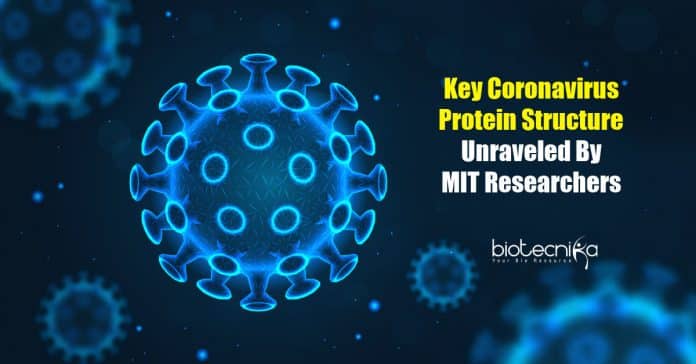Key Coronavirus protein structure unraveled
The coronavirus pandemic has got the entire scientific community working on the virus that changed our lives. The researchers at MIT are no different in using their knowledge to solve the problems of the world. The SARS-CoV-2 viral structure includes an envelope that is made of an envelope protein E. The MIT chemists have discovered the molecular structure of this key coronavirus protein E that forms a cation-selective channel. It plays an important role in the replication of coronavirus and in the inflammatory response induced in the host.
The paper has been published in the science journal Nature Structural and Molecular Biology. Venkata Mandala who is a graduate student at MIT is the lead author of the paper. Other MIT graduate students co-authoring this paper are Alexander Shcherbakov and Aurelio Dregni. They are joined by Mathew Mckay, a postdoc at MIT, and Antonios Kolocouris, a pharmaceutical chemistry professor at the University of Athens.
An MIT professor of chemistry, Mei Hong observed that pathogenicity and replication of the virus can be significantly reduced by blocking this protein E channel. This aspect has also been worked on by the researchers. They investigated the effect of two drugs
that have binding sites that bind weakly to the channel. This isn’t enough though to cause effective inhibition of the key coronavirus protein.Challenges faced
Cell membranes contain proteins as well as lipid moiety. This lipid membrane makes it difficult for the membrane protein structures to be studied which is what Hong’s lab specializes in. The structure of these membrane-embedded proteins can be determined by NMR (Nuclear Magnetic Resonance) spectroscopy. Hong has used NMR spectroscopy to develop techniques in order to determine the protein structures at an atomic level.
She has previously worked on the M2 proton channel which is an influenza protein that has a similar structure to the key coronavirus E protein. They are both made of many helical proteins organized into bundles. The influenza B M2 structure is basically a homo-oligomeric helical bundle which took 1 and a half years for Hong’s team to determine. They had to work on influenza protein from scratch starting from cloning, expressing, and purifying it. Since this work had made them familiar with the procedure, they were able to clone and purify the SARS-CoV-2 E in a mere 2.5 months.
They used the highest-field NMR at MIT for a non-stop period of two months, examining the spectra generated from a 900 MHz spectrometer and on two other spectrometers of 800MHz and 600MHz. In order to carry out their experiments, the researchers embedded the coronavirus protein into a lipid bilayer which imitates a cell membrane. They found out how the transmembrane domain is the part of the protein embedded inside assembles into a bundle of 5 helices which are highly immobile.
This channel is tighter and much more restricting than the M2 channel of the influenza virus. It also differs greatly in appearance from the M2 protein which is much more mobile and the Vpu protein of HIV-1 which has an equivalent transmembrane protein that is shorter with a wider pore. Hong and her colleagues are planning to conduct further research on the impact of E structure on the functions and life cycle of the SARS-CoV-2 virus.
Although the structure of the key coronavirus protein has been determined, it is believed to be the closed state of the channel. Cations such as calcium may be attracted to one end of the channel which contains several important amino acids. The researchers hope to find out how the channel opens and closes from further studies on its open structure.
How it can contribute to COVID treatment
Such fundamental research can help find solutions to many medical problems according to Hong. The channel can be inhibited by drugs like amantadine and hexamethylene amiloride which bind to the E protein. While amantadine is an influenza medicine, the latter is used to treat high blood pressure. But these are weak inhibitors which prompt the medical community to formulate stronger inhibitors that can treat Covid-19.
Hong further emphasized the importance of fundamental scientific research. Research into microbial proteins should continue with the same energy even after the pandemic. We have seen how the structure of the key coronavirus protein can be a solution to an entire pandemic. Therefore, compromising on fundamental research would mean compromising on human life itself. And that I believe, is one thing that has proven this year to be invaluable.
Author: Deepthi Prakash






























